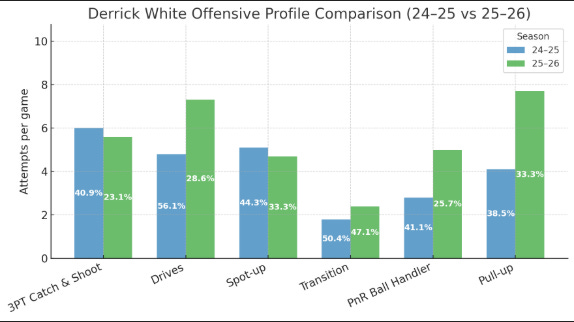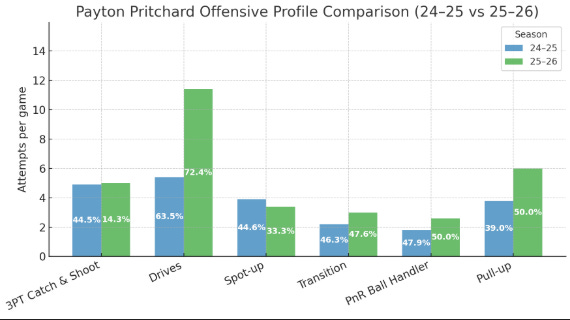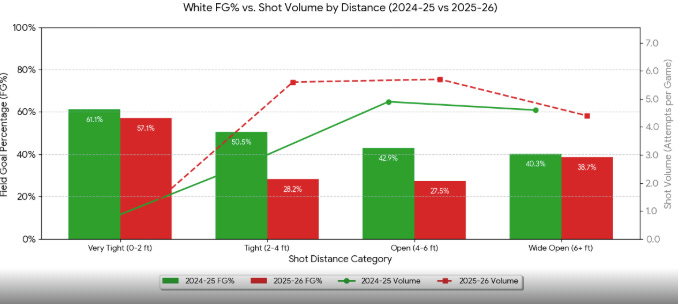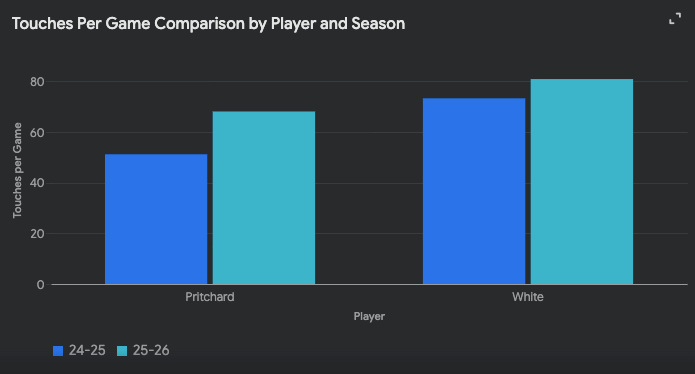Can White and Pritchard Figure It Out?
The Boston Celtics' duo are struggling to make their impact felt.
It’s been a bumpy start to the season for Derrick White and Payton Pritchard, at least as far as scoring is concerned. The duo has combined to shoot 26-of-118 from the perimeter over the first seven games, good for 22% from 3-point range.
And while both guards have begun to adjust their shot profiles, we won’t see the best of Boston’s new starting backcourt until they start draining their shots from deep.
However, it’s not as simple as just making your shots.
Pritchard and White are playing in totally new roles, with an additional focus on shot creation and playmaking. Interestingly, their shot profiles haven’t shifted as drastically as you would expect.
As you can see in the graphs above, Pritchard has undergone the most significant shift, increasing his drives per game from 5.4 per game last season to 11.4 over the opening seven games. White, on the other hand, has seen an increase in his PnR ball-handling, but has found limited success when shooting the rock (25.7% shooting).
Both guards have been forced into taking more shots off the dribble (pull-ups). Interestingly, Pritchard’s increase in pull-up jumpers has come from two-point range, with only 2.1 attempts coming on the perimeter, a decrease of almost 1 shot per game.
In recent years, both White and Pritchard have enjoyed the luxury of coming off pin-downs or flare screens to get high-quality shooting opportunities. Opposing defenses were stretched out due to the talent on the floor, and as a result, shots were easier to come by and make.
This year, those actions are being run for Jaylen Brown, who has embraced a leading role within the offense. That has meant that both Pritchard and White are adapting to a significant increase in shot difficulty.
The data support the increased shooting difficulty that White and Pritchard are facing. According to NBA Stats, both guards are underperforming on their XFG% (expected field goal percentage), with Pritchard a -17% on his 3PT XF and White roughly 11% under. This highlights the tougher shots both are facing early in the season.
Both guards are working through an adjustment period. Their struggles are more pronounced because they’re sharing the floor together, and neither is providing the perimeter scoring punch that fans have come to expect from them. Their struggles are both intertwined and individualistic at the same time.
The best way to explain this is that White and Pritchard have their go-to skills. They’ve thrived when put in a position to lean on those go-to moves. However, this season, they’re being asked to lean on other areas of their game, and that’s leading to discomfort and forced development.
We’ve all been there. Even with something as simple as our comfort show on TV. If that show isn’t available — maybe Netflix took it off, or the streaming platform is down for maintenance — then you pivot to a different show. And while that show is fine, you don’t feel as comfortable as if you had your first choice — abstract, I know…But I’m a sucker for a comfort show at bedtime.
As you can see in the above graphs, Pritchard and White are both operating at a higher overall volume to begin the new season, and that’s likely where some of the discomfort comes from.
With increased touches, the learning curve is steep for two players leading Boston’s new guard-led offense.
While the perimeter scoring drought is concerning, it’s vital to recognize the positive elements of this “forced development.” Pritchard is proving himself by averaging 5.6 assists per game this season. Likewise, Derrick White continues to be a crucial connective piece and is a defensive anchor, ranking in the 93rd percentile for Defensive Estimated Plus/Minus to begin the season.
Nevertheless, it’s inevitable that the longer White and Pritchard struggle as a duo, the louder calls will become for Anfernee Simons to slide into the starting unit.
The case for keeping Simons on the bench
Throughout the summer, I was very high on the notion of keeping Pritchard in his sixth man role. He had proven himself to be elite when coming off the bench, and on the surface, it made little sense to move him into the starting lineup.
Nevertheless, Pritchard has earned his spot in the starting lineup. And while there are clearly some teething issues, as we covered above, it doesn’t make sense to switch things up so early into the season. Mazzulla needs to give his new backcourt time to figure things out, both individually and as a unit.
Moving Pritchard to the bench now could impact his overall confidence, and there’s no guarantee that Simons would fare much better. Pritchard gets off the ball a lot quicker than Simons does — or at least, has shown to begin the season. White is already dominating the team in touches. Combining Simons and White, while still playing a high-tempo game, would require another adjustment period.
As we’re still so early in the season, it makes more sense to allow White and Pritchard the room they need to adjust. If they’re still struggling as we near the 20-game mark, then perhaps a change will be in order.
The case for putting Simons in the starting unit
There is a fair argument to be made that Simons’ experience as a lead ball-handler could allow White to shift back into a secondary role, where he can lean into his catch-and-shoot threat and make reads when attacking off the bounce. Simons is a proven commodity when it comes to leading an offense, and could easily absorb a significant amount of White’s on-ball creation responsibilities.
Furthermore, moving Simons into the starting lineup would put Pritchard back into a role he knows and thrives in. He would still get starter-level minutes, or close to it, and could rediscover his shooting touch without facing off against opposing teams’ best defensive units.
The only question is how Simons would fare on the defensive end, and whether he could remain viable in Mazzulla‘s system when facing primary and secondary scorers.
The Verdict
It’s too soon to make a change.
The data shows that White and Pritchard are getting good shots, but the change in role is leading to a disconnect, especially in terms of execution. They’re both talented enough to adjust, if given the time.
It is worth noting that when looking at the graphs above, we’re pulling a seven-game sample size and comparing it to a full season’s worth of data…Still, that’s all we’ve got to work with, and considering the importance of getting White and Pritchard on track, it made sense that we at least explored what could potentially be limiting their impacts.
I say give it 20 games. See where things stand after that. If the struggles still continue, then tweak the rotations or move Simons into a starting role. Until then, I’m trusting White and Pritchard to figure things out…








Nice post. I prefer Pritchard as the 6th man. Brings instant energy and sparks the team.
Shot selection seems like a major issue right now. Both of them are launching with more aggression but SOMETIMES they are not the best shots. Pritchard made a 3 last game and immediately took a tough 3 on the next possession, hoping he was hot I guess. Simons is included in this as well. Be aggressive shooting 3's but make sure they are open shots, especially early in the shot clock. I loved 10 assist Pritchard by the way, the team in general needs to share the ball more and if Payton becomes more of a playmaker, I'd be happy as hell with that...